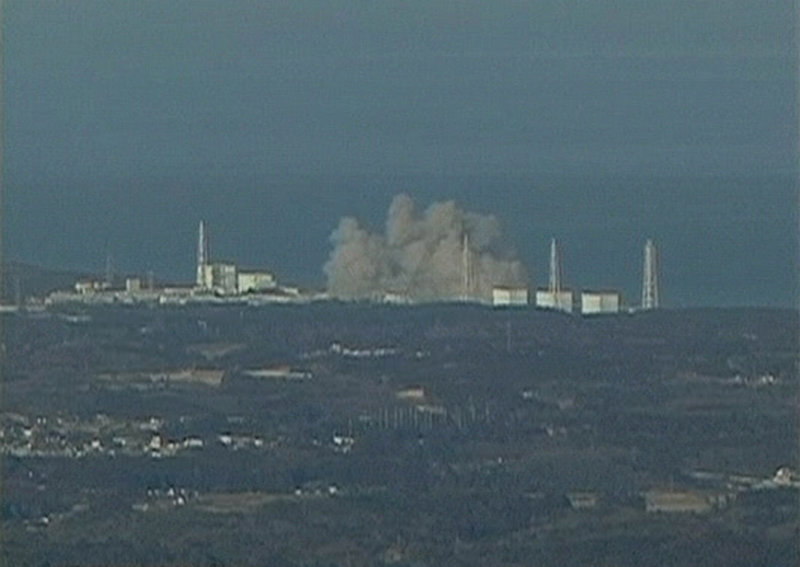UTSUNOMIYA, Japan – More than 170,000 people were evacuated Saturday after an explosion at a nuclear plant hurled plumes of smoke over the Pacific Ocean and sent officials scrambling to calm residents already shattered by the largest earthquake in Japan’s recorded history.
Japanese authorities hastened to assure the public there was no danger of a meltdown at the Fukushima Daiichi plant along the lines of the 1986 disaster at the Chernobyl nuclear plant in Ukraine, but they were unable to explain why excess levels of radiation were detected outside the plant’s grounds.
Japanese Cabinet Secretary Yukio Edano said the explosion at the Fukushima Daiichi plant was caused by a buildup of hydrogen in the cooling system. He insisted that the explosion didn’t cause any damage to the reactor itself but merely caused the collapse of a wall outside.
“We are evacuating people just as a precaution,” Edano said at a news conference, as television footage showed white smoke billowing from the reactor, followed by a black cloud. “There is no risk to inhabitants of the area.”
Japan’s NHK television reported that at least three residents among 90 tested at random showed excess exposure to radiation. The people had apparently been exposed as they waited outside a school for evacuation by helicopter, the network said, citing local officials.
The International Atomic Energy Agency said it was told by Japanese officials that they would distribute iodine tablets to residents nearby. Iodine is known to protect against thyroid cancer that can develop from radiation poisoning.
Just as people were trying to get back their equilibrium after Friday’s magnitude-8.9 earthquake, which left hundreds dead and thousands missing, the nuclear accident was an added blow to the psyche.
“I’ve gotten used to the earthquake. But this business with the radiation has me more worried,” said Eri Tamada, a 22-year-old medical student who had fled Fukushima for Utsunomiya, 50 miles away. She and a classmate had been trapped for three hours on a train when the quake struck Friday, and they spoke with slightly quavering voices, clearly rattled from their experience.
“First the earthquake, now the nuclear accident. We’ll never know what the future holds,” said Tamada’s friend, 24-year-old Hideyuki Shimizu.
Although there was no visible damage in the Utsunomiya area from the quake, electricity had been off most of the day.
On the only major road north from Tokyo still open, convenience stores displayed empty shelves stripped bare the day before.
Sawada Chiharu, 29, who was pumping gas along the road, said: “With this nuclear accident, it’s worrying. We don’t know if the government is telling the truth, but what can we do but go and do our jobs?”
The Fukushima nuclear plant is 150 miles north of Tokyo and 40 miles from the earthquake’s epicenter.
The biggest concern about the plant is the possibility of the core overheating and nuclear material escaping from the containment vessel.
When the earthquake struck Friday afternoon, the reactors automatically shut down as they were supposed to, a safety measure built into the design. But cooling systems — which were supposed to remain on — apparently failed because they couldn’t get enough electricity. Four backup diesel generators to supply emergency power also failed.
On Saturday, officials said that the plant’s engineers were using seawater in an attempt to cool the reactor. They were also releasing steam containing low levels of radiation as an emergency cooling measure.
Japan’s heavy dependence on nuclear power — which supplies 30 percent of its energy — makes it even more vulnerable in an earthquake.
“Japan is an earthquake-prone archipelago, and lining its waterfront are 54 nuclear plants. It’s been like a suicide bomber wearing grenades around his belt,” said Katsuhiko Ishibashi, a professor emeritus at Kobe University.
Copy the Story Link
Send questions/comments to the editors.



Success. Please wait for the page to reload. If the page does not reload within 5 seconds, please refresh the page.
Enter your email and password to access comments.
Hi, to comment on stories you must . This profile is in addition to your subscription and website login.
Already have a commenting profile? .
Invalid username/password.
Please check your email to confirm and complete your registration.
Only subscribers are eligible to post comments. Please subscribe or login first for digital access. Here’s why.
Use the form below to reset your password. When you've submitted your account email, we will send an email with a reset code.